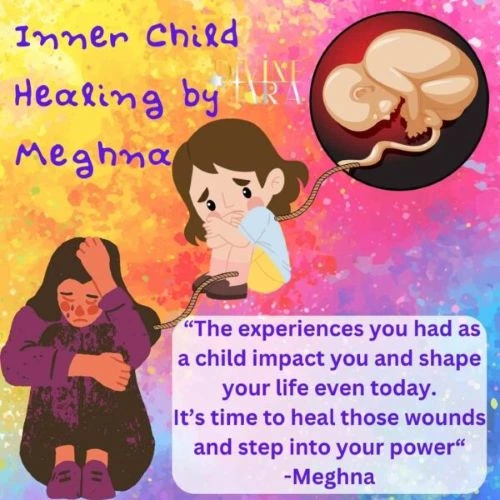Inner Child Healing By Meghna
December 18, 2023
2025-03-30 18:14
Inner Child Healing By Meghna
Do you struggle with low self-esteem?
Do you often worry that the people in your life will eventually leave you?
Do you often feel guilty standing up for yourself?
Do you constantly criticize yourself for being inadequate or unworthy?
Do you feel ashamed of expressing strong emotions like anger or sadness?
Do you find it difficult to trust yourself and other people?
Are you an addict or have been addicted to something?
Do you prioritize other people’s needs over your own?
Are you scared to express yourself or give your opinion in front of everyone?
WHAT IS INNER CHILD WOUNDING?
The inner Child is the child within us who didn’t have their emotional needs met. We all have a younger part of ourselves that was “never quite loved the way we needed to be loved.” Your childhood is not a separate part of your life. The experiences you had as a child affect your life even today. However, many people are unaware of this connection and end up struggling with physical, emotional, and mental health problems.
Inner work is the act of going deep within ourselves, to reconnect with the forgotten, rejected, and painful emotions that we buried very deep in the subconscious. We carry wounds from all the smallest emotional neglects to physical abuse.
When these deep hurts are not addressed they are brushed under the carpet and ignored, and one moves on in their lives projecting an image of being ‘strong and independent’ to the world. We may learn to suppress or ignore our emotional needs as a way of coping.
This kind of living transforms into behaviors destructive to ourselves and our environment. We betray ourselves by developing patterns of workaholism, alcoholism, codependency, people-pleasing behaviors, looking for constant approval from the outside world, lack of confidence, lack of self-worth, self-sabotaging, self-sacrificing yourself for others.
This leads us to a feeling of being disconnected or lost as we grow older. We are not in control of our lives as we navigate directionless in this world, following and doing what the world dictates.
By healing our inner child, we begin to create the safety and security our younger selves have always needed. We shine in the world by tapping into our gifts.
“When we heal the inner child, we heal generational patterns as we become very conscious of the damage unhealed emotional wounds can do.”
There are a few broad issues that dominate our worldview, and the way we look at ourselves. These are identified as several categories, Meghna will be covering each wound and she will take you through the deep-rooted wounds from your childhood and teenage years, healing and reinvigorating the very essence of your being.
REJECTION WOUND
The root cause of this wound is Shame. And a feeling of being unworthy of love. Feeling rejected by parents, loved ones, society, friends, or past lovers can create internalized shame.
The rejection wound is the manifestation of feelings of grief, shame and being ‘unaccepted’ and it paves the path for the child to feel anxious or self-loathe.
Rejection is a deep-rooted phenomenon believed to have come through from ancient times when there was a need to ‘belong’ to a group or a tribe.
Not belonging or being ‘rejected’ meant death, this led to the deep-rooted need for acceptance and we feel mortified when rejected. This may lead to several emotional, behavioral and mental disregulation within an individual.
-
Feels ‘not good enough’
-
Fears rejection and hence use the ‘escape strategy’ or an extreme solution, for that relationship, job, or space before they are ‘asked to leave.
-
Deliberately isolate oneself even when they want to belong.
-
Fears not being liked by the people
-
Have internalized the invalidation of the past ‘rejections’
-
You avoid getting involved with people you are interested in, choosing safety.
-
Self-sabotaging your relationships
GUILT WOUND
Guilt wounds stem from being criticized or made to feel inadequate by caregivers during childhood. These individuals often feel responsible for other people’s feelings and feel the need to ‘manage’ them.
These individuals might have grown up in abuse, neglect, bullying, or dysfunctional settings. The child might have been shamed for their choices or made to feel guilty if they went against the wishes of the caregivers. These children might have also been blamed for the shortcomings of their caregivers and not receiving their support. This made the child feel guilty for asking or expecting their caregivers’ support in any way.
Individuals with this wound may experience severe guilt saying no to the smallest of the occurrences. They tend to overthink their responses in the past and keep beating themselves up, experiencing anxiety and a sense of worthlessness for setting the smallest boundary. As these individuals didn’t have their needs met, they grow up feeling everyone else shares their feelings of deprivation even when they don’t.
-
Feels “sorry” or “bad” for the smallest of the things.
-
Doesn’t like to ask for things
-
Uses guilt to manipulate
-
Is afraid to set boundaries
-
Normally attracts people who make them feel guilty
-
Overly sensitive to other’s feelings and anticipating the needs of others.
-
They may overextend on someone even when it’s not convenient for them, failure to please people leaves them feeling drained, depressed, and guilty.
-
Fear of being inadequate, or a need to compete against other people
-
Fear of getting into or being in trouble, almost like it’s a constant threat
-
Fear of abandonment or rejection
-
Feelings of guilt when they achieve something.
-
A need to ‘get even’ when they’ve been wronged or offended
TRUST WOUND
Were you constantly let down by your loved ones while growing up?
Did you feel violated by the very people closest to you and you felt that you were misunderstood?
Constant let downs, being lied to, and mistreatment leads to the development of the trust wound. A trust wound will stand in the way of you trying to be vulnerable with people, the fear of ‘taken advantage of’ will preoccupy you. These individuals find it difficult to trust others in the basic-most aspects of life since they hold strong traumas of ‘not being cared for’ in their childhood. A plethora of doubt is instilled by their caregivers which leads them to not only mistrust others, but also themselves.
-
Doesn’t trust themselves
-
Find ways not to trust people
-
Feels insecure and needs lots of external validation
-
Doesn’t feel safe
-
Normally attracts people who don’t feel safe
-
Fears exploring new activities or ideas
-
Defensive or always guarded
-
General mistrust towards everything
ABANDONMENT WOUND
The feeling of ‘left out’ or ‘discarded’, the abandonment wound is deep-seated emotional distress.
Being ignored or given the silent treatment, emotionally unavailable caregivers or being screamed at or punished for no reason.
-
Feels “left out”
-
Is afraid of being abandoned
-
Hates being alone
-
Is codependent
-
Threatens to leave
-
Normally attracts emotionally unavailable people
-
Feel the need to ‘earn’ love
-
Not being good enough
NEGLECT WOUND
The neglect wound arises when an individual does not get adequate attention from their caregivers. They may also be deprived of physical needs such as clothes or quality nutrition. The neglect wound manifests into many personality and mental health issues such as low self-esteem, attention disorders, anger issues amongst others.
-
Finds it difficult to let go
-
Feel that they don’t matter to their loved ones
-
Has low self-worth
-
Gets angry easily
-
Can’t say no
-
Suppressed emotions
-
Avoids being vulnerable
-
A sense of disconnection with their caregivers
-
Normally attracts people who don’t appreciate them or make them feel seen.
TEENAGE INNER WOUNDS
Inner teenager healing acknowledges the early inner child wounds and provides space to feel, , verbalize, and process all the feelings and emotions that you had no choice but to suppress to keep the peace in your early environments.
-
Unexpressed anger
-
Not feeling safe to speak your truth.
-
Emotionally reactive from the pain that they’ve been feeling for so long, especially around family
-
A rebellious spirit may engage in self-sabotaging behaviors.
-
Overspending, procrastination, emotional eating, addictions, and tends to seek romantic partners that aren’t a good fit.
FATHER WOUNDS
Childhood is a very impressionable period, this is where the child forms perceptions not only about the world, but also about themselves. The first social interaction a child has is with his/her caregivers. The child always internalizes any dysfunctionality, toxicity, or normalness as the ‘absolute’. Every dysregulation in the behavior of the caregiver or the atmosphere at their homes is often rationalized by the child if not regulated in time. Children tend to internalize their parents’ behavior as their fault.
Father wound is a long term consequence of a person’s father being physically absent, emotionally distant or abusive, negative or overly critical.
-
A father-wound can instill feelings of not meeting expectations.
-
Not being good enough and being undeserving of love.
-
Low self-esteem can result in an individual:
-
Never pushing themselves in school or work
-
Difficulty in connecting with others
-
More susceptible to substance abuse
-
A father wound can leave a person feeling low, depressed or anxious about their parental relationship.
MOTHER WOUNDS
The Mother Wound is passed through generations of women in patriarchal cultures and
how your mother’s unprocessed trauma impacted you. This has an influence on one’s relationships with themselves and others.
-
Not feeling good enough
-
Shame
-
Feeling you must remain small in order to be loved.
-
A persistent sense of guilt for wanting more than you currently have.
-
Not being your authentic self because you don’t want to threaten others.
-
Having a high tolerance for poor treatment from others.
-
Feeling competitive with other women.
-
Self-sabotaging behaviours.
-
Being overly rigid and dominating.
-
May lead to eating disorders, depression and addictions.
ATTACHMENT STYLES
“Communication is key to any and every relationship missing which creates unnecessary chaos and overthinking in the mind. These stem from inner child traumas. It is important to understand the ‘whys’ of every behaviour. Self observation and awareness is important as we keep healing aspects of ourselves along the way”
~ Meghna
Attachment styles describe the ways we connect and communicate with our loved ones.
This is most often an unconscious choice. The way we form relationships as adults has a lot to do with the way we felt and formed our initial social relationships with our caregivers.
Our very world-view is based on the way we have felt, and made to feel by our caregivers/inner circle while growing up.
ANXIOUS ATTACHMENT
Do you feel the constant need to reach out to your loved ones or significant others for reassurance or affection, even if it disrespects your own boundaries?
Maybe your attachment style is Anxious.
Neglectful or inconsistent parenting could make the child believe they would be abandoned or neglected, and feel they have to put in ‘the work’ to make any relationship work. Such individuals derive all of their validations from how people perceive them in a relationship.
-
Feel a need for constant validation or have low self-esteem.
-
Feel anxious, threatened or worried if their partner wants space, or tries to set a physical boundary.
-
Constantly ‘give’ to others in order to feel significant.
-
Might be preoccupied with the thoughts of being abandoned by their partner.
-
Feel responsible for the emotional well-being of others
-
They might be people-pleasers too
AVOIDANT ATTACHMENT
Individuals with Avoidant or Dismissive attachment style might be very social, professionally successful but tend to avoid real intimacy or closeness in their relationships.
They might believe that they don’t need emotional closeness with anyone in life.
Such individuals were made to feel ‘not provided for’ whenever they sought emotional help from their caregivers, during their childhood. They often conclude that people cannot be relied upon and hence, they simply stop seeking or expecting any kind of closeness from others. It’s a decision they unconsciously made as children.
-
Even though you might be an outgoing person, they tend to avoid apparent displays of emotions.
-
If a relationship demands more of them, they close themselves to any kind of emotional intimacy or commitments.
-
Irrespective of how confident or successful these individuals are in their professional or social life, they might be the core reason for their own dysfunctional relationships.
-
They might struggle to form deep, meaningful, and long-lasting relationships that can be painful for people with this attachment style.
ANXIOUS – AVOIDANT ATTACHMENT
Individuals with an Anxious-Avoidant Attachment style may feel the urge to have emotionally close relationships, but become distant and anxious when a progression occurs. They might ‘back off’ when their partner or a loved one tries to get closer than their comfort zone.
Such individuals may have experienced dismissiveness and invalidation of their feelings from their caregivers in their childhood. Parents whose children become avoidant might avoid expressing their own feelings.
When the child expresses a desire for emotional closeness, instead of receiving it, they are made to feel a ‘door shut on the face’ treatment by their caregivers. Any strong emotions such as joy, excitement, sadness or fear is disregarded and not tolerated.
Caregivers can become angry and try to disrupt the child’s behavior by telling the child to toughen up. The parent expects the young child to behave independent, serious, and reserved.
-
They may enter a relationship feeling emotionally present but take a step back when more is asked of them, instilling anxiety, distress, or distance.
-
They might feel overwhelmed by their partner’s attempt for affection causing them to partially or completely avoid commitment.
-
Even though they crave love, they have a tendency to show avoidance behavior.
-
They might feel that they will never be able to find a significant other, and hence prefer being alone and channelize all their energy towards other goals/pursuits.
SECURE ATTACHMENT
An individual with a secure attachment style may exactly know how to navigate their own feelings as well as be present for their significant others. Their own emotional regulation is at par with their emotional experiences. Such individuals are in awareness of their choices and behaviours with others.
Caregivers of such individuals are responsive and attuned to the needs of their children.
The emotional regulation of these children has been stable and rock solid, leading them to understanding their own emotions. Such a stable framework and parenting leads to building a secure attachment style.
-
Feeling emotionally close to others
-
Being aware of how and when to set boundaries
-
Accepting the boundaries of others
-
Moving on from relationships that no longer serve them
-
Having open and direct conversations about conflicts
-
Making their own choices and having a healthy level of independence
-
Detecting red flags in the behavior of potential partners or friends
-
Knowing when to let go
You have to visualize your inner child standing in front of you. Your inner child will come to you in whichever age you have traumas coming.
“I will make sure that you don’t talk to anyone you don’t want to, I am giving you my assurance that I’m going to protect you. I’m going to make sure that no harm comes to you. You are completely safe.”
– Meghna




